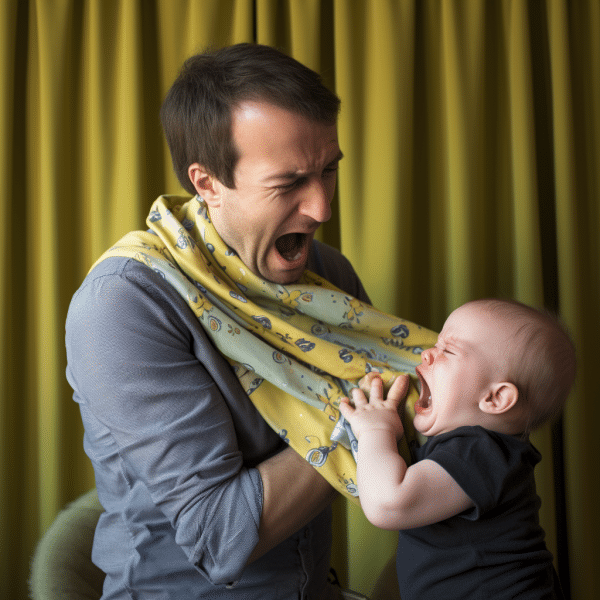
Mastering Baby Burping: A Gentle Approach for Parents
Mastering Baby Burping Burping a baby after they’ve been fed is an essential element in caring for a newborn. It helps dispel any trapped air in the tummy, making them more relaxing and significantly lessening the probability of colic or other digestive issues. Nevertheless, when it comes to executing this procedure correctly, caution needs to be exercised to keep the little one safe and comfortable.

Can You Burp a Baby Too Hard?
It is imperative that parents take time to gently burp their little ones as it can positively impact both their comfort and digestion. However, vigorous burping should be avoided as it may lead to deleterious consequences for the baby.
Risks:
- Bruising or injury to the ribs, chest, or back
- Damage to internal organs
- Increased discomfort for the baby
- Risk of vomiting or regurgitation
Signs of Burping Too Hard:
- Crying or fussiness during or after burping
- Arching of the back or stiffening of the body
- Refusal to eat or drink
- Vomiting or spitting up
- Irritability or lethargy
If you spot any of these warning signs, it’s vital to modify your burping technique and method to guarantee that you aren’t belching your infant too forcefully. It’s essential to remain gentle and understanding while burping your child – as releasing any air bubbles can take some time.
Related: BLOWING IN BABY’S FACE- IS IT SAFE
MECE Approach to Burping Babies
Evaluating the full gamut of alternatives when it comes to burping babies? The MECE(Mutually Exclusive, Collectively Exhaustive) method has you covered – offering a structure that makes sure all potential avenues are explored, and none of them overlap. From postural recommendations to techniques to consider and how regularly they should be applied, this framework provides an easy approach to unlocking the mystery of baby burping.
Burping Positions
Using the MECE model, parents and caregivers can approach burping their baby in three distinct ways: over the shoulder, sitting upright on the lap, or lying face down across the lap. Each of these methods are autonomous and independent of one another, so it is important to rotate through all three in order to ascertain which works best for the infant.
Burping Techniques
For parents and caregivers seeking a successful way to burp their babies, the MECE framework provides several helpful techniques such as patting, rubbing, and gentle bouncing – all of which are mutually exclusive. An experiment should be conducted to identify which one is most effective for each baby.
Burping Frequency
Parenting can be a tricky business, and the task of burping a baby can be just as daunting. To help guide parents through the process, an effective solution is to use the MECE framework.
Related: HOW LONG AFTER FEEDING SHOULD I BATHE BABY
This enables them to test different approaches – such as after each feeding, midway or only at the end – to discover what works best for their specific child. With this technique in hand, parents and caregivers can confidently approach even the most demanding of parenting activities.
How to Burp a Baby Safely
With one hand supporting the infant’s chest and chin, use the other to gently administer pats or rubs on the back.
Observe signs of a successful burp, such as changes in breathing or air expulsion. Multiple attempts in various positions or using different techniques may be needed. Be patient and allow ample time for burping; rushing can complicate the process.

How Long Should You Burp Your Baby?
When you’re burping your baby, it’s only natural to be mindful that you don’t do it for too long and become overly vigorous. The experts advise actively, yet gently patting your baby for five minutes– but if they appear content during this time, then stop regardless.
Related: CAN YOU BOTTLE FEED A BABY IN A CAR SEAT
So use your baby’s reactions as your guide: if they seem distressed, you may be doing something wrong. Avoid leaving marks and observe closely to ensure your baby is enjoying their meal– and those grateful belches will surely follow.
FAQs:
Q: How often should I burp my baby?
A: Burp your baby after each feeding, but keep in mind that each baby is unique, and some may require more or less frequent burping. Experiment with different burping frequencies to determine what works best for your baby.
Q: Can you burp a baby too hard?
A: Yes, it’s possible to burp a baby too hard, which can cause injury and discomfort. Signs of burping too hard include crying or fussiness, arching of the back, refusal to eat or drink, and vomiting or spitting up. Be gentle and patient when burping your baby, and adjust your approach if you notice any signs of discomfort.
Q: What if my baby doesn’t burp?
A: Not all babies will burp after every feeding, and this is normal. If your baby doesn’t burp after a few minutes, it’s okay to continue with the feeding. However, if your baby seems uncomfortable or gassy, you can try burping them again after they finish eating.
Q: Can I lay my baby down immediately after burping?
A: After burping, hold your baby upright for a few minutes to minimize the risk of regurgitation or vomiting. However, once your baby is comfortable and settled, you can lay them down for sleep or play.
Q: Can I use a burping cloth or towel?
A: Yes, using a burping cloth or towel can help prevent spit-up and make clean-up easier. Place the cloth or towel over your shoulder or across your lap to catch any spit-up or drool while burping your baby.